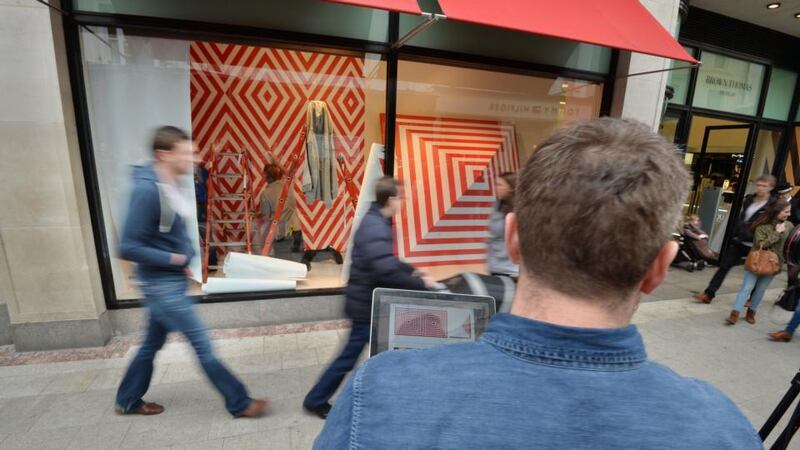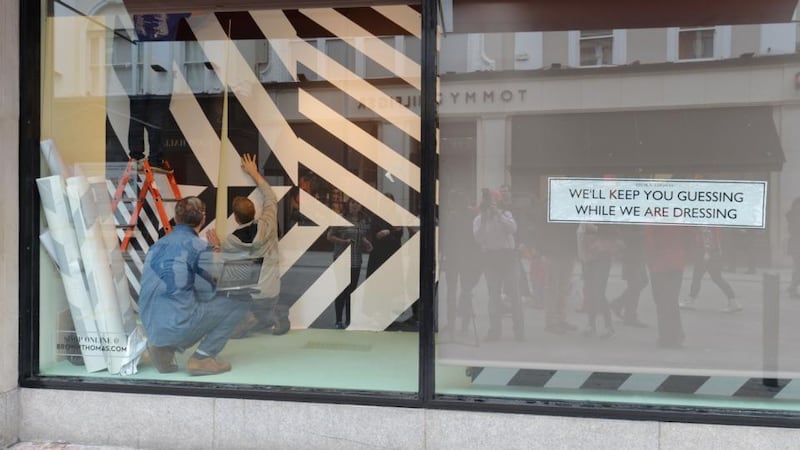When you hear that Ireland’s foremost graffiti artist has done the Brown Thomas windows you might think we’re into poacher-turned-gamekeeper territory. Maser made his name from covering walls with illicit artwork; now, he has gone behind the most iconic walls in Irish retail. Renegade or not, the result is delightful.
Maser’s zebra stripe has been wallpapered around a boxy set for the mannequins in the Dublin and regional stores. For those lured all the way to the cash register, there will be limited-edition bags in baby blue with his tag, a Maser-wrapped love heart.
This was not an easy undertaking for Maser. “At first I was like, ‘Work with Brown Thomas, how does that look for me as a graffiti artist?’ Then I thought of it as really exciting, because I’ve known those windows for years,” says the south Dubliner over tea upstairs in the Dublin branch. He remembers being a child, holding his mum’s hand, walking past the old Switzer’s. “I remember the windows were important. It’s a landmark space in Dublin city centre.”


But did he have to abandon his principles? “No,” he says firmly. “It’s just bringing more worlds together. My world and Brown Thomas’s world. It’s an acceptance from Brown Thomas that our little world, our subculture, is acceptable. And by me doing it, us accepting them too.”
So who is Maser? He is about 30. He worked as a sign painter, studied art, and he paints all over Dublin. He is an international success, making street art, print work and installations around Europe and America. We don’t know a lot about him because he wants to stick to the street art tenet of anonymity. Instructions to the photographer were not to shoot his face, and, in this interview, he skirts around half the questions, grinning all the while.
He has been spraying and stencilling walls since his teens. He and his friends found their mode of self-expression in places such as Windmill Lane, by U2’s recording studio. “There are no social boundaries. If you’re in a football club it could be dictated by where you live, or your social class. With graffiti, you’d have a kid from Blackrock hanging out with a kid from Ballymun. The only important thing was how good you were at painting. We were fearless kids, almost like little entrepreneurs.” This was in the mid-1990s, before Banksy and before Irish street artists became people to watch. “We weren’t cool. No one expressed an interest in what we did,” says Maser.
He is undoubtedly cool now, but he is not the rapscallion you might expect. This is no creaturely type in a paint-spattered hoody, but a smiley, grizzled hug of a man with big brown eyes and a fashion sense. He wears a striped flannel shirt, buttoned to the top, a vintage fawn, quilted coat and strong jeans. Why won’t he have his picture taken? “I just like to be able to go to the pub and have a pint with my mates and let the work speak for itself,” he says. “I’m sure my ma would love to see my face in the paper.”
Life in Arkansas
He is enjoying "the simple life", living in Fayetteville, Arkansas, with his girlfriend, Lou, also an artist. He is just back from Berlin, where he made a room of blocky stripes. "Dublin's small and it's beautiful and it's romantic but I just need to take a break, and focus on my craft, and bring Dublin with me," he says.
We want some nail-biting stories from the boy who has gone from vandal to fashion darling. Did he ever get caught? “Yeah, can’t really get into that,” he says.
“What’s your real name?” I ask.
“I’m not telling ya,” he shoots back.
“Why?”
“I’d just rather not.”
Dublin isn’t an easy place to achieve anonymous celebrity. “I like the work to just stand out,” he says. “I’d rather be a messenger.” If he starts seeing his face in the media, he will wonder “what are my intentions? For me to be famous or for my work to get recognition?”
So far, his work has shone vibrantly beyond the solipsistic tag of the street artist. The murals, impossible to miss in Dublin, are encompassed by the same idea you find on the BT bag: love. He collaborated with Damien Dempsey on a project called They Are Us, spreading Dempsey's lyrics on concrete and raising €40,000 for homeless charities. Among the bold-faced messages of hope was "farewell to your stairwell forever", painted down a now-demolished, nine-storey block in Ballymun. Recently, for Limerick City of Culture, he covered a petrol station in Limerick, down to its pumps and two cars, in his emblematic disco stripes.
Now his work is the backdrop to Prada, the proverbial devil of fashion. Fashion and graffiti have been having a bitter-sweet relationship, with fashion pursuing graffiti in either a bid for street cred or a recognition that the movement is, in Maser’s words, “bigger than the Renaissance”. The Chanel, Céline and Prada shows for spring-summer 2014 all featured either sets and murals by street artists, or clothing splashed with graffiti motifs. Céline drew upon the work of the late Hungarian graffiti photographer Brassaï, and its tribal patterned T-shirts recalled the subway artist Basquiat. Chanel then bemused even the world of fashion with its spray-canned canvas rucksack, priced at $3,400.
When worlds collide
An astonishing ideological clash happened between the two worlds during 2012-2013. Kidult, a rage-driven, anti-capitalist Parisian, spray-painted Marc Jacobs's New York shop with the word "Art". Jacobs had the work photographed and printed on to a T-shirt priced at $686. Kidult splashed the Paris shop with "$686", and Jacobs capitalised again. Last September, during the fashion week that inspired Brown Thomas's canny creative team, Kidult targeted Chanel.
Kidult’s mission statement, that “luxury brands appropriate graffiti for publicity, thereby pushing me to react by vandalising their stores with real graffiti”, is not shared by Maser, who respects fashion. He sees it as art, but knows more about street style. “I obviously like to have a nice pair of kicks. Kicks are very important.” He has an urban clothing label called Homebird with his stylist friend Leah Burke. Going between art and clothing design “keeps it fresh”.
Love and stripes
These Brown Thomas windows bring to mind candy canes and sailboats, and the bag's throbbing vintage heart is sure to create good commercial vibrations. "The word 'love' is quite strong," he says. "Love is quite infectious, because a lot of the street artists in Ireland are doing a lot of love-based stuff now," says Maser. He uses stripes because, like a tag on a street, they "interrupt someone's day-to-day flow".
Maser is less interested in increasing Brown Thomas’s turnover than in his mother getting joy from the windows. He hopes to “inspire some young heads. I want young artists to see that if you work really hard and are fearless in your approach, you can do what you want to do”. Asked which world he feels closer to, Brown Thomas or the young heads, he replies: “Obviously mine. But I can see both.”
I catch sight of a tattoo swirling up his wrist and he pulls up his sleeve to show the words “Family and friends before fortune and fame”.
Maser's window designs are in Brown Thomas on
Grafton Street until
May 18












